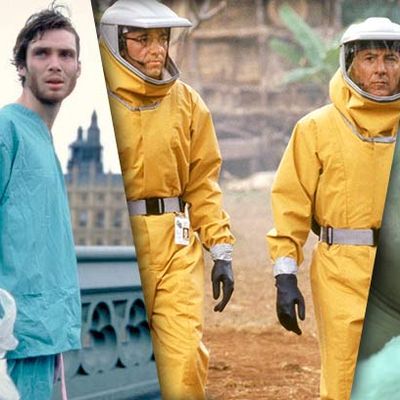
Ebola has arrived in the United States, and people are freaking out. Part of this is because of professional scaremongering, and part of this is because we’ve been primed to panic by decades of cinema history. After all, you don’t make a movie about a deadly virus without having that virus get loose and decimate entire populations. (Successful Quarantine is a much less catchy title than Contagion.) From the Motabo virus of Outbreak to the “Captain Trips” super-flu of The Stand, the movies’ depictions of mass sickness can get very dire indeed. Here’s what we’ve learned from Hollywood Epidemiology 101.
The Initial Transmission
It’s a normal, average day — normal, that is, until Something Happens. Maybe it’s a chef forgetting to wash his hands before greeting customers (Contagion), maybe it’s an Alzheimer’s cure not working as planned (Rise of the Planet of the Apes), or maybe it’s a satellite returning to Earth with an unexpected visitor (The Andromeda Strain). Either way, the symptoms usually appear mild at first, just some coughing, maybe a bloody nose. By the time anyone realizes how dangerous the situation is, it’s already too late.
The Disease
Ebola is an unpleasant disease (are there any pleasant ones?) that causes vomiting, diarrhea, and severe bleeding. However, it could be much worse. In the movies, an infection could turn you into a zombie (28 Days Later) or a vampire (I Am Legend) or an underground mutant (The Omega Man). Even when their symptoms are realistic, movie diseases have outrageously high fatality rates. The simian flu from Dawn of the Planet of the Apes eliminates 90 percent of the population, but that’s the common cold compared to The Stand’s “Captain Trips,” which kills 99.4 percent of people on Earth. (The current outbreak of Ebola has a fatality rate around 50 percent.)
Patient Zero
If you’ve seen any medical thriller, you know the first and most important thing to do is find the index case, which is key to understanding the virus and, at least in Outbreak, finding a cure. In recent films, this is almost always an international air traveler. Gwyneth Paltrow’s adulterous businesswoman in Contagion picks up MEV-1 in Hong Kong and spreads it to Macau, Chicago, and Wisconsin, while the end credits of Rise of the Planet of the Apes show the simian flu spreading through an infected airline pilot. The trope is scarily prescient: Ebola’s patient zero in the U.S. is Thomas Eric Duncan, a Liberian man who flew into Dallas to visit friends. He’s presumedly much more sympathetic than Gwyneth.
The Spread
As Nancy Grace reminds us, Ebola cannot be spread through the air, only by bodily fluids, and only by someone who’s already symptomatic. This is comforting, since much of the paranoia of disease films comes from the fact that you could catch it at any time, from anyone — even the ones you love. This might be a good point in the post to get up and wash your hands.
The Quarantine
At some point, the epidemic will spread far enough that the authorities will get involved. If they’re nice, like in Contagion, they’ll set up a quarantine. If they’re mean, like in Outbreak, they’ll set up a quarantine and then try to firebomb everyone inside. Either way, their efforts usually fail.
The Fall of Civilization
Ebola hasn’t resulted in total societal breakdown yet, and cable news stations aside, most of us hope it never will. But if it does, at least we’ll have a playbook to follow. Things will start off with a little minor looting.
Then we’ll get a breakdown of law and order, maybe the fall of a government or two.
Then, if the movie’s grim enough, things will get really bad. Major cities will be abandoned (28 Days Later), and the few survivors will band together in tunnels underneath Philadelphia (12 Monkeys) or a decrepit tower in San Francisco (Dawn of the Planet of the Apes). If you’re unlucky enough to be living in a universe dreamed up by Stephen King, an enigmatic wanderer will rise to power, and he’ll turn out to be the embodiment of all human evil (The Stand).
The Cure
The good news is, movies often take a few creative licenses with epidemiology, and most real-life viruses could never cause the kind of worldwide destruction we see onscreen. The bad news is, movies take these same creative licenses when it comes to medicine. In Outbreak, Dustin Hoffman synthesizes a cure for the fictional Motaba virus that instantly cures everyone who was infected with the disease. Contagion is less ludicrous, but still depicts the discovery of a successful vaccine a few short weeks into the epidemic. After that happens, though, a teen girl gets to slow-dance with a vaccinated hunk to the lovely sounds of U2. That’s a happy ending no matter what the medical establishment says.


